Explore the Merchant Center
This tutorial assumes you have imported the SUNRISE Data to your Project.
Introduction
The commercetools Merchant Center is a user interface-driven command center for you to manage product data and product types, discounts, orders, categories, and customer data for all retail channels with just a few clicks. Additional functions, such as configurable forms and batch processing, help you to easily complete your daily tasks. In this section, we take a quick tour of the Merchant Center and some of the important functionality it provides. For more detailed information on the Merchant Center and specific functionalities, visit the Merchant Center Documentation.
Explore the Project Settings
Setting up Internationalization
Currencies, languages, and countries define the localization aspects of your commerce project and environment. All these can be configured by accessing the Merchant Center, and navigating to Settings > Project settings > International as described in the Merchant Center Documentation.
Currencies
In the sample data set the two currencies EUR and USD are provided, which means that your project is currently configured to sell products in those currencies. This project configuration allows you to add prices to SKUs on those currencies, maintain taxes and shipping costs or even set promotions for those specified currencies.
Languages
Every localizable field (product attributes, meta tags, search keywords, etc.) will provide options to store the translated content for each of the languages that are configured in the Project settings. In the example data you will find content for English (en) and German (de). Storefronts and other API clients can consume these translations which you can preview and manage in the Merchant Center.
For example, navigate to Products > Product list and select a product. In case your user profile is set to English language you'll find the name in English listed there. If your profile is configured to German language you'll find the German product name listed in the Product's General information instead. Either way, you can check the names of all other configured languages by clicking Show all languages.
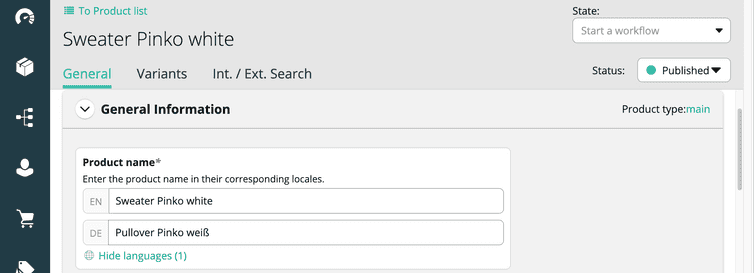
Countries
The country configuration determines where the products stored in the product catalog can be sold. This setting also allows you to set up different tax categories and prices per country, and it allows a single site to be served to different countries and/or geographic regions. In the Merchant Center you can see that the following countries are configured in the sample data: Germany (DE), Austria (AT), United States (US), and Netherlands (NL).

Zones
The SUNRISE data example defines two geographic zones in which the shop is meant to deliver orders for the same shipping costs: United States (which covers the USA) and Europe that includes the countries Austria, Germany, and the Netherlands. These Zones are then assigned to the Shipping methods.
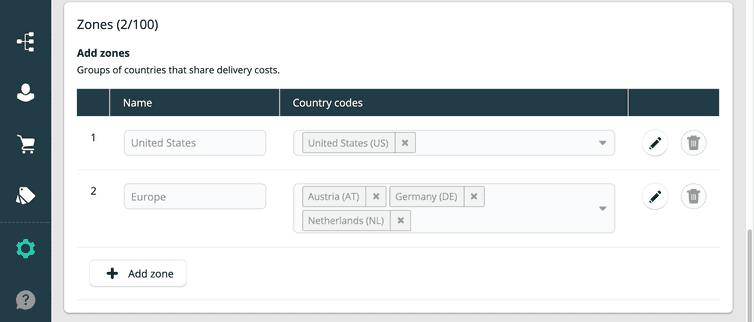
Creating Tax Categories
By default, the commercetools platform will calculate the sales tax for each product when they are added to the cart. The calculated tax rate needs to be configured by setting up a tax category which will contain tax rates that are configured per country within a tax category.
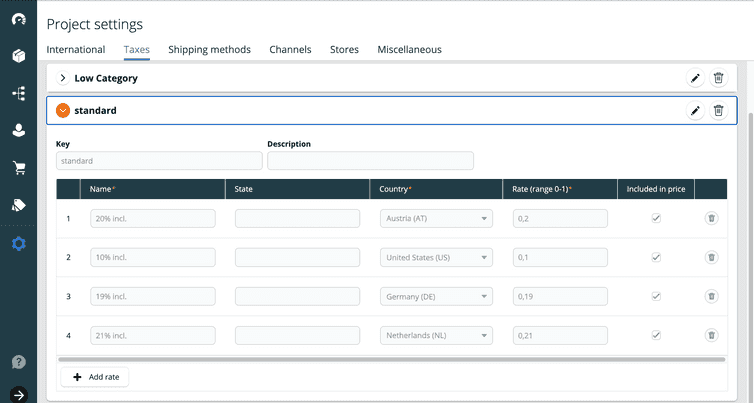 After navigating to Settings > Project settings > Taxes, you should find the two tax categories Low Category and standard, that are specified in the SUNRISE Data Set. The Low Category is meant to be for all products that can be sold at a reduced tax rate depending on the tax regulations in the countries you want to sell your products in. When expanding the standard tax category, you'll see that the tax rates are configured for each of the countries defined in the International section of the Project settings.
The tax rates are given as decimal numbers, so 0.19 is equivalent to 19% VAT in Germany.
After navigating to Settings > Project settings > Taxes, you should find the two tax categories Low Category and standard, that are specified in the SUNRISE Data Set. The Low Category is meant to be for all products that can be sold at a reduced tax rate depending on the tax regulations in the countries you want to sell your products in. When expanding the standard tax category, you'll see that the tax rates are configured for each of the countries defined in the International section of the Project settings.
The tax rates are given as decimal numbers, so 0.19 is equivalent to 19% VAT in Germany.
The included in price marker is checked for all tax rates in this example which means that all the prices on your products with this tax category have the VAT included already. The platform will then calculate the net prices for these to be shown in the cart together with the tax amount. In case you don't want to show gross prices in your storefront, as it is common for B2B shops, or you want to use a third-party tax calculation service for the United States, leave that marker unchecked for the specific tax rate.
You can later assign one tax category to your products what will define which tax is applicable to each product.
For more advanced tax calculation use cases, the default behavior of the platform can be overridden so that an external tax calculation provider can be integrated smoothly.
Setting up Shipping Methods
Multiple shipping methods can be created in a commercetools project. This can be used for use cases like standard delivery, express delivery or click & collect. Creating a shipping method allows our platform to calculate the exact shipping rate to apply to a cart/order and even make it free if above a specific cart/order value.
To provide different shipping services for your business you can define specific shipping methods that have their individual shipping rates and delivery zones.
Manage the shipping methods with the Merchant Center after navigating to Settings > Project settings > Shipping methods.
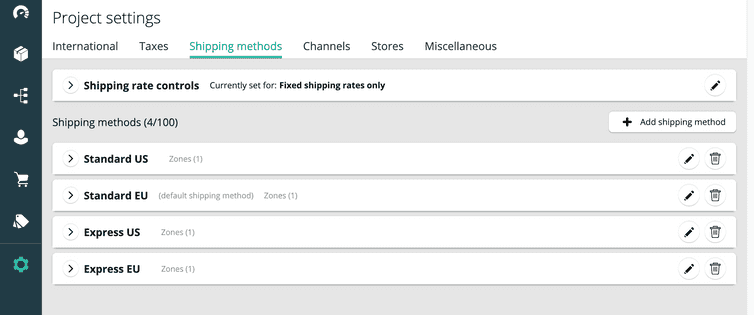 The SUNRISE example presents you four shipping methods, a Standard and an Express service for the EU as well as the US region. The Standard EU method is set as default shipping method in your project.
The SUNRISE example presents you four shipping methods, a Standard and an Express service for the EU as well as the US region. The Standard EU method is set as default shipping method in your project.
Since VAT is also applied on shipping costs, each of the shipping methods has one of the aforementioned tax categories assigned; in the example the methods for America are taxed with a US Tax Category and the EU method is taxed with the standard category applied in the European countries configured before.
The geographic zones defined above are used on the shipping methods here to define that the delivery services are restricted either to Europe or to the United States. You can configure currency-specific shipping rates also if needed, but since the countries in our SUNRISE data example are all in the eurozone, this is not required for this use case.
Shipping methods can have more advanced rules added as Predicates. To gain more experience on those, please see our tutorial on this topic
Setting up Channels
On commercetools, a channel is a grouping concept that can be applied to product prices or inventories. Using product distribution channels allows you to set different prices for the same SKU (each channel has a corresponding price). The use of inventory supply channels enables you to track different stock levels for the same SKU (each Channel will have its own inventory management capability). This allows you to represent a warehouse, a distribution hub, or even a physical retail space with a respective Channel.
When navigating to the Settings > Project settings > Channels tab in the Merchant Center you will find several channels modeling physical stores in different cities that are defined in the SUNRISE Data example. All of these channels have both Channel roles assigned: Inventory Supply and Product Distribution. When you look at the products in SUNRISE Data you'll find channel-specific prices specified on the product variants. If you have imported the inventories from the SUNRISE Data set into your project also, you will find different stock levels for each channel on the SKUs.

Explore Daily Operation Features
Managing Customers
You will find some example customers in your project that were imported with the SUNRISE Data Set when you navigate to Customers > Customer list. The Merchant Center provides the ability to add customers manually, but in reality your store front will provide self-sign-up for your shop customers so that you only need to adjust details like assigning them to customer groups you might have created for your bonus card members or other loyalty programs.
All customers are uniquely identified by their email that will be used by the storefront or any other API client to authenticate the customer on the platform. Their passwords are stored on the platform in encrypted format and you can't see the current password in the Merchant Center, but you can assign a new password to a customer if needed.
On the Addresses tab you can manage the Shipping and Billing addresses of a customer. The country of the shipping address will be used to calculate the shipping costs for deliveries to this address specified on a customer's order.
On the Orders tab you will find all orders the customer has ever placed in your project. The SUNRISE Data Set does not provide any example for this, but you can create an order on behalf of an example customer yourself as explained in section Creating an Order.
Managing Discounts
The platform provides two main types of promotions: product discounts and cart discounts. To manage those with the Merchant Center, navigate to Discounts.
Creating a product-based promotion
Product discounts are applicable to products or product variants, typically used for presenting a reduced price on the product list and detail pages next to the original price that is crossed out. How to set up such a promotion is explained in the Merchant Center documentation.
Creating a cart-based promotion
Cart discounts apply a discount to all or a subset of items in a cart. This feature is designed for promotions like Buy-One-Get-One-Free, Free Gift, and Free Shipping. Use this promotion type when you issue discount codes to your customers that they can apply on their next order. Instructions about how to create such promotions are described in the Merchant Center documentation.
Managing Orders
The Merchant Center allows you to manage all orders that have been created by your customers via the storefront in your commercetools project. For the case that you as a member of your customer service have to create an order on behalf of a specific customer manually, you can do that in the Merchant Center too.
Manage existing Orders
After navigating to Orders > Order list you'll find a number of orders that have been imported from the SUNRISE Data Set. A search box and several filters assist you in finding orders placed in a specific time frame, from a particular customer or with the Order status Open, for instance.
Selecting an order will allow you to see details about that order:
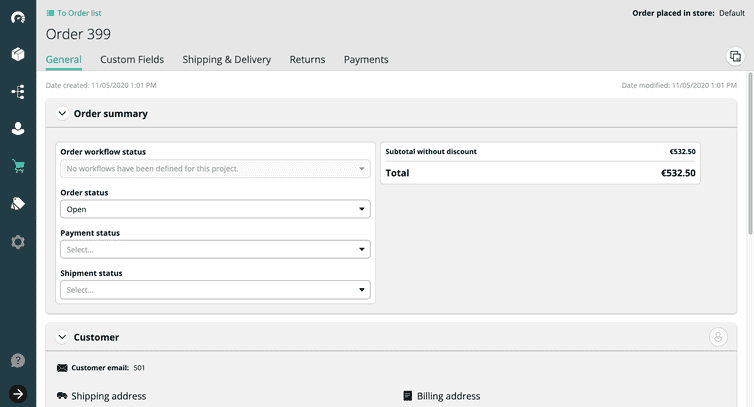 General tab
General tab
In the Order summary you can check and change the current Order status, Payment status, and Shipment status. An Order workflow status has not been defined in the SUNRISE data, if you like to set up your own order management workflow you can find more details about it in the API documentation.
The Order items section provides a list of all line items the order contains. You are able to check and set the Line item state for each of them here. The SUNRISE Data Set has three example line item states defined: Initial, Picking, and In replenishment.
Custom Fields tab
If you need additional information on your orders that cannot be captured in the standard fields of an order, you can customize them with your own Custom Fields via the API as explained in the related tutorial. The SUNRISE Data Set provides the Reserved Products field as an example for this.
Shipping & Delivery tab
While we expect that on a production environment all these fields will be updated via integration from a third-party application (fulfillment or shipping processor), you can actually not only check the status of a delivery. You can manually process a delivery, by selecting which items are being shipped, even going as far as adding additional parcel data.
Returns tab
You can initiate a return process from this screen - add the return details and select which items are being returned. This will not override the initial order data - instead it will just add additional return data to an order. Any other business logic can be applied with additional backend workflows (outside the Merchant Center).
Payments tab
This screen contains all payment-related data (status, amounts, IDs) associated with an order to track the transactions with an integrated Payment Service Provider (PSP).
Creating an Order
To simulate a shopping experience you can press the Add Order button in the upper right corner of the Order list.
Follow the wizard that manually creates an order on behalf of a customer. With this you proceed through the following steps:
- you select the Currency for your cart
- you select the Customer associated to the cart
- you add line Items to that cart
- you select a Shipping method
- you confirm the operation, transforming a cart into an order
You can also copy an order and all its details by pressing the Copy this order button on the top right corner of the screen.
Creating your own experience
By now, you have learned the key concepts of the Merchant Center and are ready to explore further. We can suggest that you return to the Merchant Center and try setting up a more customized set of data for your specific use case, or begin connecting our APIs and start consuming data for use with your commerce project.
